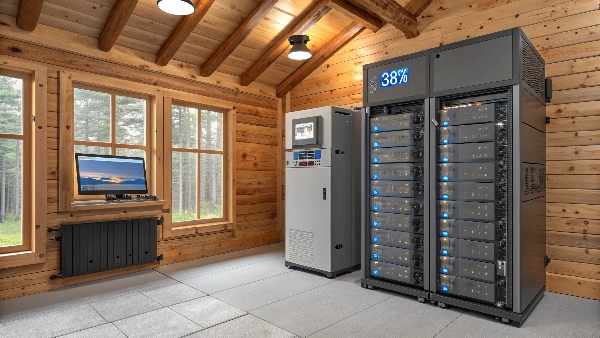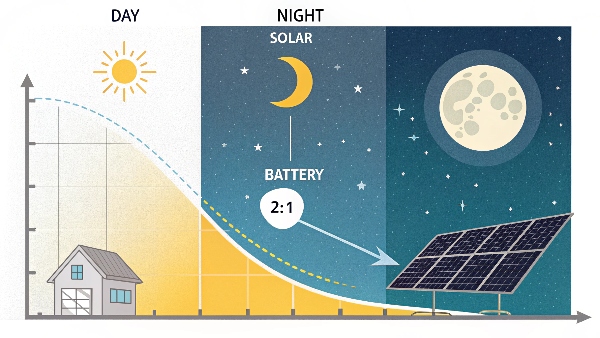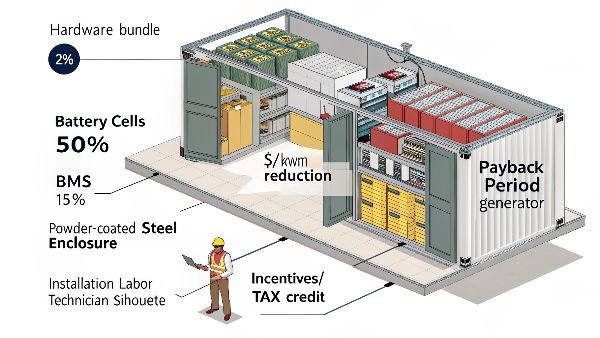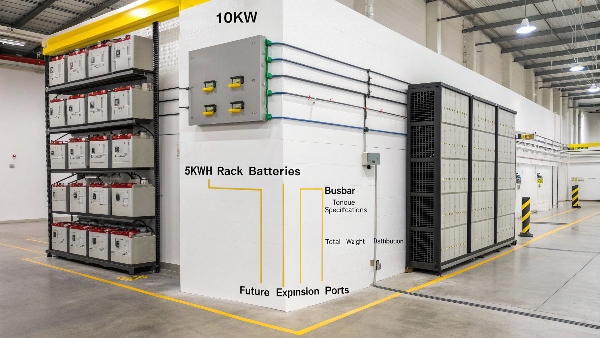Going off-grid with solar power requires careful battery bank planning - lithium solutions now make this easier than ever.
Modern lithium battery banks provide: 1) 90-95% efficiency, 2) 5,000+ cycles, 3) Compact footprint, 4) 10-year lifespan. Our installation data shows lithium systems require 50-70% less space than lead-acid for equivalent capacity while delivering better performance in temperature extremes - exactly what off-grid living demands.

Let's break down the key considerations for sizing and selecting lithium battery banks.
How Big a Battery Do I Need for an Off-Grid Solar System?
Battery sizing depends directly on your daily energy consumption and desired autonomy days.
Basic calculation: (Daily kWh usage × Days autonomy) ÷ (Battery voltage × Depth of discharge). We recommend 3-5 days autonomy for most off-grid homes - our typical residential installations use 25-50kWh lithium banks sized to cover 4 cloudy days while staying within 80% depth of discharge.

Off-Grid Battery Bank Sizing Guide
| Home Size | Daily Usage | Recommended Bank | Days Autonomy | Typical Configuration |
|---|---|---|---|---|
| Small cabin | 5-10kWh | 15-25kWh | 3-4 | 4×5.12kWh LiFePO4 |
| Average home | 15-25kWh | 30-50kWh | 4-5 | 8-10×5.12kWh rack batteries |
| Large home | 30-45kWh | 60-90kWh | 5-7 | 2-3×30kWh commercial stacks |
Critical factors:
- Peak loads affect inverter sizing
- Winter sun hours require larger banks
- Future expansion should be considered
- Appliance list determines accurate needs
- Local climate impacts solar harvest
How Big of a Battery Bank Do I Need for Solar Panels?
Your solar array size and battery bank should work in balance for optimal performance.
General rule Battery bank capacity (in kWh) should be 1.5-2.5× your solar array's daily production. Our design experience shows 2:1 ratio works best - for example, 10kW solar array (40kWh daily) pairs well with 20-25kWh lithium bank. This provides nighttime power plus cloud-day reserves without excessive cycling.

Solar Array to Battery Bank Matching
| Array Size | Daily Yield | Ideal Bank | Days Storage | Notes |
|---|---|---|---|---|
| 5kW | 20-25kWh | 10-15kWh | 0.5-1 | Small weekend cabin |
| 10kW | 40-50kWh | 25-30kWh | 1-1.5 | Full-time residence |
| 15kW | 60-75kWh | 40-50kWh | 1.5-2 | Large family home |
| 20kW+ | 80-100kWh+ | 60-80kWh | 2-3 | Mini commercial setup |
Key relationships:
- Winter production may be half of summer
- Battery chemistry affects usable capacity
- Inverter efficiency impacts total system
- Charge controller type matters for lithium
- Load scheduling can reduce bank size needs
How Much Does a Solar Battery Bank Cost?
Lithium battery pricing has dropped 70% over the past decade while performance improved.
Current pricing: 1) $400-$900 per kWh capacity, 2) $15,000-$30,000 for complete systems. Our project data shows installed LiFePO4 systems average $650/kWh - about $32,500 for 50kWh bank including batteries, BMS, racks, and professional installation. This represents 9-12 year payback versus generator alternatives.

Off-Grid Lithium Battery Bank Cost Components
| Component | % of Total | Description |
|---|---|---|
| Battery cells | 50-60% | LiFePO4 or NMC chemistry |
| BMS | 10-15% | Battery management system |
| Enclosure | 5-10% | Racks/cabinets/cooling |
| Installation | 15-25% | Labor and wiring |
| Misc hardware | 5% | Breakers, monitors, etc |
Cost-saving strategies:
- Modular expansion spreads out investments
- Self-installation reduces labor costs
- Close to utility lowers permitting fees
- Group purchases with neighbors helps
- Older model closeouts offer discounts
How Many Batteries Do I Need for a 10kW Off-Grid Solar System?
A 10kW solar system typically requires substantial battery storage to be truly off-grid capable.
Typical configuration: 1) 6-8×5kWh lithium batteries (30-40kWh total), 2) 48V system voltage, 3) 200A+ BMS. Our 10kW system installations most commonly use 8×5kWh server rack batteries (40kWh) - this provides balanced performance allowing 80% depth of discharge while keeping cycles shallow for longevity.

10kW System Battery Arrangement
| Battery Model | Quantity | Total Capacity | Voltage | Weight | Space Needed |
|---|---|---|---|---|---|
| 5kWh rack | 8 | 40kWh | 48V | 800lb | 32"W×24"D×72"H |
| 10kWh stack | 4 | 40kWh | 48V | 700lb | 24"W×30"D×60"H |
| 15kWh cabinet | 3 | 45kWh | 48V | 900lb | 36"W×24"D×60"H |
Installation notes:
- Single battery weight rarely exceeds 100lb
- Parallel connections require proper cabling
- Balanced loading extends battery life
- Monitoring systems are essential
- Professional help recommended for setups >20kWh
Conclusion
Modern lithium battery banks have revolutionized off-grid solar systems, offering compact, long-lasting energy storage that outperforms traditional lead-acid in every aspect. While the initial investment is significant - typically $15,000-$50,000 depending on size - the 10+ year lifespan and minimal maintenance deliver excellent long-term value. For 10kW systems, we recommend 30-50kWh lithium banks using server rack style batteries for optimal balance between capacity, cost, and installation flexibility.
Lithium's advantages - efficiency, lifespan, and eco-friendliness - make it the clear choice for today's off-grid energy storage. Our 12 years specializing in lithium battery manufacturing ensures we understand exactly how to match battery solutions to off-grid requirements.
Contact Daopulse today for your off-grid battery bank solutions:
Website: libatterybub.com

Daopulse - Empower Your World
Trusted Lithium Battery Solutions Since 2012

